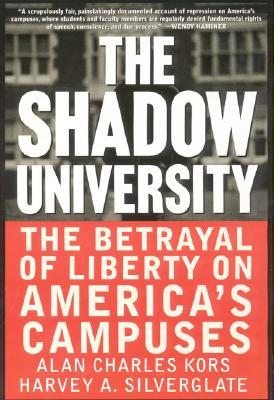The introductory chapter of The Shadow University contains a powerful indictment of contemporary higher education. Kors and Silverglate get it right when they characterize university administrators as “careerists who have made a Faustian deal.” They are correct as well about the professorial, political, and cultural pressures that have turned institutions of learning into conduits of multiculturalism and victimological concern. Since administrators need to stay in the graces of nonideological trustees, vocationally minded parents, and charitable alumni, they typically shove the nuttiest professors and the silliest courses into the liberal arts.
To deal with minority grievances, administrators appoint deans who invariably form working alliances with liberal arts protectors. This is the way universities infect themselves, according to Kors and Silverglate: by creating and “walling off a shadow university” that exists to accommodate aggrieved ideologues. By now, the authors argue, the “walled-off” secondary university, having swallowed up the original one,
engages in systematic intimidation. . . . The first imposition, in the classroom, is merely an abuse of a power that generally may be awarded by choice and in any event is not accomplished in secret. The second imposition of the shadow university is inescapable and is an exercise in something truly chilling; a hidden, systematic assault upon liberty, including idealism, dignity, due process, and equality before the law.
Alan C. Kors is a professor of European history at the University of Pennsylvania and, unlike Harvey Silverglate—a long-time civil rights lawyer—views himself as a conservative libertarian. The horror stories which Kors and Silverglate relate in detail about gay, feminist, and black racist bullying of students and faculty at the University of Pennsylvania, the University of Delaware, Cornell, and other institutions of learning have received earlier publicity. But until this book shed light on the walled-off part of university life, few trustees and alumni knew much about these issues, if only because of the mendacious advertising earmarked for such groups. Alumni publications from Yale and Harvard foster the illusion that those universities have changed only minimally in the last several decades.
Kors and Silverglate believe that their disagreeable research will force alumni and trustees to see their alma maters clearly and encourage them to restore to these institutions some measure of their former dignity. They argue that faculty demanded “hate speech” and “hate thought” codes are not simply concessions to governmentally imposed guidelines. Once in high gear, liberal arts faculties and minority affairs deans ignore judicial decisions protecting free speech. In one grotesque case, cited by Kors and Silverglate and featuring an art exhibit at the University of Missouri, the EEO director on campus ordered pictures taken down and then put back up, depending upon his changing opinion of whether they depicted blacks “in a sufficiently positive light.”
The authors devote much—perhaps too much—of their attention to the case of Eden Jacobowitz. An Orthodox Jewish student and descendant of holocaust survivors, Jacobowitz was temporarily ousted from the University of Pennsylvania after calling a noisy black girl a “water buffalo.” Like other white male students accused of insensitivity, Jacobowitz was made the object of hysterical maltreatment: However, he was able to count on the support of the Anti- Defamation League, the ACLU, and other left-of-center, Jewish organizations that raised hell in his defense. The otherwise flawlessly p.c. dean of the Temple Law School, Robert Reinstein, broke ranks to come to the aid of this son of holocaust survivors. Jacobowitz told his accusers “that everything in his being, his upbringing, and his religious commitments forbade racism,” but in such cases, the expressed beliefs of the accused hardly matter. The simple truth is that he was being railroaded from the university by government-sponsored bullies, while the black student groups involved in his departure were playing a politically profitable game by going after him. When the forces arrayed against Jacobowitz in early 1993 turned on a gentile, Greg Pavlik, it was Kors who stood up to them. That this student newspaper editor who refused to lie about black violence on campus managed to survive at the University of Pennsylvania mayhave been entirely due to Kors’ intervention.
Despite the unflattering but altogether accurate portrayal of the p.c. epidemic at the University of Pennsylvania, and the shocking exhibition of minority-kow-towing given by its president, Clintonbacker Sheldon Hackney, one doubts that Penn’s “betrayal of liberty” or of scholarship will cost it any students. People will continue to apply there in droves, despite the lack of due process and the prevalent Star Chamber techniques that mark the university’s handling of cases involving minority grievances. There are social and professional advantages to attending and graduating from prestigious institutions, and no matter how strongly critics like Kors rage against them, the tangible value of attending certain schools will, for many people, overshadow the truly alarming situation described in The Shadow University.
[The Shadow University: The Betrayal of Liberty on America’s Campuses, by Alan Charles Kors and Harvey A. Silverglate (New York: The Free Press) 415 pp., $27.50]

Leave a Reply